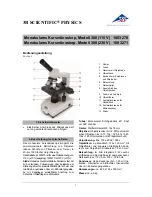
3
7) Turn the focusing knob until the objective lens is almost touching the slide. Don’t let the lens
touch the slide as you may break the slide and damage the lens. Now look through the eyepiece
and slowly turn the focusing knob back until you see the sample clearly.
How to Make a Prepared Slide
Samples for examination should be very thin so that light can pass through them. If the sample is
too thick it will appear dark in the microscope.
Cloth fibers, pollen, dust or salt crystals will be easy to see and make good samples for beginners
to observe.
A) Making a Temporary Slide
1) Wipe the slide clean.
2) Prepare a thin sample. You may have to slice it with a scalpel or a razor blade. Be
very careful. You may want to ask for adult help.
3) Pick up your sample with the tweezers and put it on the center section of the slide.
Add one drop of water.
4) Gently place a temporary slide cover (plastic) over the sample, being careful not to
allow any air bubbles in.
5) Remove any excess water with a piece of paper towel by pressing it down gently
over the slide cover.
6) Now you can observe your slide.
B) Making a Permanent Slide
1) Start with a clean slide and cover glass. The cover glasses are very thin and can
break easily. Take care when handling these slide covers.
2) Follow Steps 2 and 3 as above.
3) Before placing the cover glass over your sample add several drops of Gum Media,
Canada Balsam or transparent glue.
4) Place the cover glass gently over the sample and gently squeeze out any air
bubbles.
5) Place your new slide away in a safe place and let it dry for a day.






















